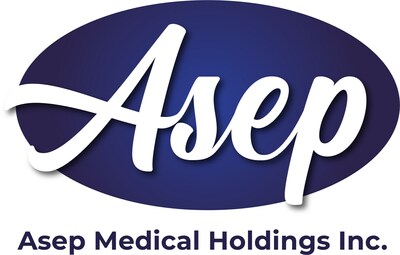Asep Medical';s Sepsis Diagnostic Technology Can Provide Improved Odds for Pediatric Appendicitis
The link between appendicitis severity and sepsis was discovered as a result of a single-centre prospective exploratory diagnostic clinical study published online in the JAMA (Journal of the American Medical Association) Pediatrics on February 19, 2024, in an article titled Gene Expression Profiling in Pediatric Appendicitis, Dhillon et al., with Asep CEO Dr. Robert Hancock as senior author.1 Thus, the gene expression signature that is foundational to the Company's AI-based sepsis diagnostic technology, called SepsetER TM, was able to distinguish between simple appendicitis (SA) and perforated appendicitis (PA), which was found to be a much more severe sepsis condition.
According to a related editorial article by Maurizio Pacilli et al.2, in the same issue, "SA has a mortality rate of about
The clinical study asked, "What blood-based mechanistic changes distinguish pediatric patients with perforated appendicitis (PA) from those with simple appendicitis on presentation to the emergency department?"
The study found that the "diagnostic study of 71 patients with pediatric appendicitis using systems immunology methods revealed a mechanistic understanding of severe disease, indicating immune dysregulation similar to that observed in sepsis. A blood-based gene expression signature of PA was also derived, providing a potential diagnostic for pediatric PA. Further work4 indicated that the SepsetER gene signature was similarly diagnostic and, in fact, overlapped with the 4-gene signature."
The study concluded that early diagnostics and management strategies for pediatric PA should be informed by underlying immune dysregulation and similarities to sepsis. Given that Asep is in advanced pre-clinical development of their sepsis gene expression in vitro diagnostic test, SepsetER, it is likely that this test may assist with diagnoses of the most severe forms of childhood sepsis in the future.
Dr. Robert E. W. Hancock, Asep Medical's Founder, Chairman and CEO, commented, "This study took place in 2017 in
Asep Medical Holdings Inc. (www.asepmedical.com) is dedicated to addressing the global issue of antibiotic failure by developing novel solutions for significant unmet medical needs in human medicine. The Company is a consolidation of three existing private companies, all with technology in advanced development — Sepset Biosciences Inc. (proprietary diagnostic tools to enable the early and timely identification of sepsis), ABT Innovations Inc. (broad-spectrum therapeutic agents to address multi-drug resistant biofilm infections), and SafeCoat Medical Inc. (an antibacterial peptide medical device coating technology).
Sepset Biosciences Inc. (www.sepset.ca) is in the final stages of preparation for clinical studies and commercialization of an in vitro diagnostic test that involves a patient gene expression signature that helps assess the development of severe sepsis, one of the significant diseases leading to antibiotic failure since antibiotics are the primary initial treatment for sepsis. Sepsis was responsible for nearly
ABT Innovations Inc.'s (www.abtinnovations.ca) peptide technology covers a broad range of therapeutic applications, including bacterial biofilm infections (dental, wound, sinusitis, skin, medical device infections, chronic infections, lung, bladder, ear-nose and throat, orthopaedic, etc.), anti-inflammatories, anti-infective immune-modulators and vaccine adjuvants. The company is in the pre-clinical development phase with promising data for the first three indications.
SafeCoat Medical Inc.'s (www.safecoatmedical.com) technology encompasses anti-fouling self-assembling polymers combined with conjugated antimicrobial peptides, which can be applied to various surfaces as antimicrobial and anti-fouling coatings. In particular, the invention relates to coatings that may be applied to multiple medical devices and implants, and feasibility has been demonstrated in animal models. The company's expertise also encompasses the methods for manufacturing and applying these anti-bacterial coatings.
This news release contains certain "forward-looking statements" within the meaning of such statements under applicable securities law. Forward-looking statements are frequently characterized by words such as "anticipates," "plan," "continue," "expect," "project," "intend," "believe," "anticipate," "estimate," "may," "will," "potential," "proposed," "positioned" and other similar words, or statements that certain events or conditions "may" or "will" occur. These statements include but are not limited to the successful clinical testing of our Sepsis in vitro diagnostic test and its intended filing for regulatory market authorization; the Company not receiving regulatory market authorization as planned or at all; the undertaking of pre-clinical studies on our lead therapeutic, with the expectation that this will lead to fast-track clinical trials; the timeframe for identification of sepsis with the company's products; the potential opportunities for the generation of revenue; the therapeutic benefits of the company's products; and other statements regarding the company's proposed business plans. Various assumptions were used in drawing conclusions or making the predictions contained in the forward-looking statements throughout this news release. Forward-looking statements are based on the opinions and estimates of management at the date the statements are made and are subject to a variety of risks including the risk that the company's products may not perform as expected; that the company may not receive the requisite regulatory market authorization or results of testing; the Company's testing of the products may not be successful and market authorization may not be obtained in the estimated timelines or at all; the company may not be able to generate revenue from its products as expected or at all; the market for the company's products may not be as described in this news release; and various other risk factors identified in the Asep Medical Inc.'s prospectus dated November 9, 2021, and in the company's management discussion and analysis, available for review under the Company's profile at www.sedar.com and uncertainties and other factors that could cause actual events or results to differ materially from those projected in the forward-looking statements. Asep Medical Inc. is under no obligation and expressly disclaims any intention or obligation to update or revise any forward-looking statements, whether as a result of new information, future events or otherwise, except as expressly required by applicable law.
1. | Dhillon BK, S Kortbeek, A Baghela, M Brindle, D-A Martin, CN Jenne, HJ Vogel, AHY Lee, GC Thompson, and REW Hancock. 2024. Gene expression profiling in pediatric appendicitis. JAMA Pediatrics, online doi:10.1001/jamapediatrics.2023.6721 |
2. | Pacilli M, Kamaleswaran R. New genetic biomarkers to diagnose pediatric appendicitis. JAMA Pediatr. Published online February 19, 2024. doi:10.1001/jamapediatrics.2023.6731 |
3. | Körner H, K Söndenaa, JA Söreide, E Andersen, A Nysted, TH Lende, and KH Kjellevold. 1997. Incidence of acute nonperforated and perforated appendicitis: age-specific and sex-specific analysis. World Journal of Surgery Mar-Apr;21(3):313-7. doi:10.1007/s002689900235 |
4. | Baghela, A. 2023. Identifying predictive gene expression signatures of sepsis severity. UBC thesis doi:10.14288/1.0412872 |
![]() View original content to download multimedia:https://www.prnewswire.com/news-releases/asep-medicals-sepsis-diagnostic-technology-can-provide-improved-odds-for-pediatric-appendicitis-302073431.html
View original content to download multimedia:https://www.prnewswire.com/news-releases/asep-medicals-sepsis-diagnostic-technology-can-provide-improved-odds-for-pediatric-appendicitis-302073431.html
SOURCE ASEP Medical Holdings Inc.










